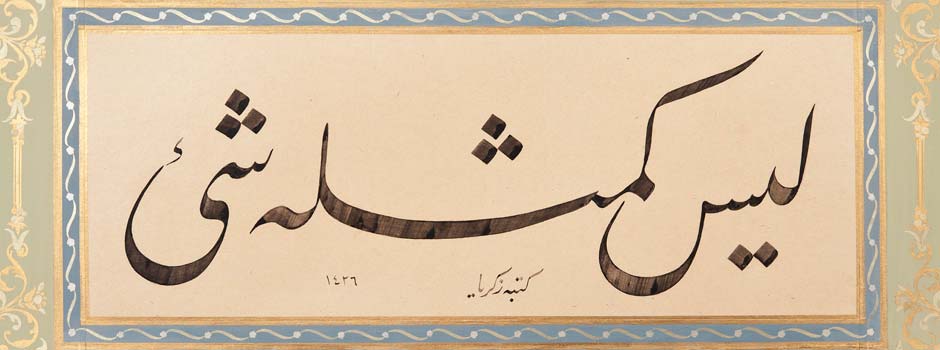
Doris Duke’s Shangri La at The Museum of Arts and Design
Sep 19, 2012 Exhibition
From September 7, 2012 through January 6, 2013, the Museum of Arts and Design will present Doris Duke’s Shangri La: Architecture, Landscape, and Islamic Art showcasing a selection of objects of Islamic art from the spectacular Honolulu home of philanthropist and art collector Doris Duke (1912-1993) and new works by six contemporary artists of Islamic background who were recently in residence there. The works from Duke’s personal collection are being shown outside of Shangri La for the first time in this exhibition, which is being organized on the centenary of her birth and which will travel after it premieres at MAD. Large-scale, newly commissioned photographs by Tim Street-Porter will establish the context of this legendary five-acre property, and a wealth of archival materials will reveal what guest curators Donald Albrecht and Tom Mellins call the “inventive synthesis†of architecture, landscape, and Islamic art that Duke achieved at Shangri La.
 The Playhouse at Shangri Laoverlooking the Pacific Ocean / Tim Street-Porter / Photo Credit: © Tim Street-Porter 2011. Doris Duke Foundation for Islamic Art, Honolulu, Hawai‘i /Courtesy of Museum of Arts and Design
The Playhouse at Shangri Laoverlooking the Pacific Ocean / Tim Street-Porter / Photo Credit: © Tim Street-Porter 2011. Doris Duke Foundation for Islamic Art, Honolulu, Hawai‘i /Courtesy of Museum of Arts and Design
Now open to the public under the auspices of the Doris Duke Foundation for Islamic Art, Shangri La today maintains a collection of some 3,500 objects and is also the site of scholar-in-residence and artist-in-residence programs. The new works in the exhibition, made in a variety of media and reflecting the mix of cultures at Shangri La, are by Zakariya Amataya (b. 1975 in Thailand, lives and works in Bangkok), Afruz Amighi (b. 1974 in Iran, lives and works in New York), Emre Hner (b. 1977 in Turkey, lives and works in Amsterdam and Istanbul), Walid Raad (b. 1967 in Lebanon, lives and works in New York), Shahzia Sikander (b. 1969 in Pakistan, lives and works in New York), and Mohamed Zakariya (b. 1942 in the U.S., lives and works in Arlington, Virginia). These contemporary works reflect each artist’s response to Shangri La’s hybrid of Islamic tradition and 20th century modernism.
“It was quite bold of Doris Duke to so passionately embrace Islamic art and architecture when she did,†says Holly Hotchner, MAD’s Nanette L. Laitman Director. “The images and objects in this exhibition demonstrate just what an active and synthetic sense of objects in time and space she had. That rare gift is amplified in the way these contemporary artists have interacted with her home. At MAD, we are always interested in how artists transform materials, and in this instance, that material is a grandly singular work of architecture and interior design.â€
Situated among five acres of interlocking, terraced gardens and pools overlooking the Pacific Ocean and Honolulu’s Diamond Head, Shangri La powerfully reflects Duke’s aesthetic passions. Seamlessly integrating modern architecture, tropical landscape, and art from places throughout the Islamic world, the home incorporates unique architectural features such as carved marble doorways, decorated screens known as jali, gilt and coffered ceilings and floral ceramic tiles. The interiors weave together artifacts such as silk textiles, jewel-toned chandeliers, and rare ceramics, many collected during her extensive international travels during her 1935 honeymoon around the world. Duke continued for the rest of her life to commission and acquire new pieces from Muslim regions specifically for Shangri La. The installation will reveal the travel and research that led to the creation of Shangri La; the process of its design; the atmosphere of life on the property during the nearly 60 years in which Doris Duke collected, commissioned and lived amid the art; and the ways in which its beauty and fusion of cultures continue to inspire artists today.
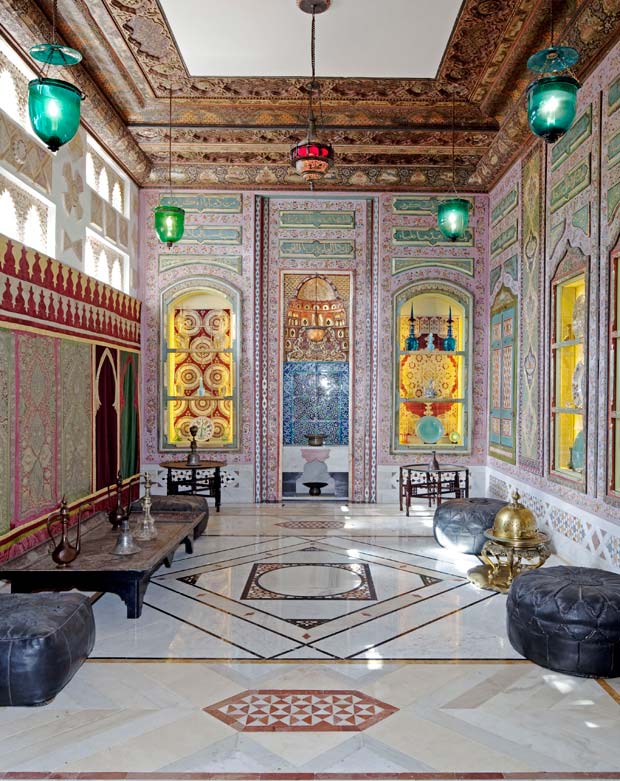 Syrian Room at Shangri La, Honolulu / Tim Street-Porter / Photo Credit: © Tim Street-Porter 2011 . Doris Duke Foundation for Islamic Art, Honolulu, Hawai‘i / Courtesy of Museum of Arts and Design
Syrian Room at Shangri La, Honolulu / Tim Street-Porter / Photo Credit: © Tim Street-Porter 2011 . Doris Duke Foundation for Islamic Art, Honolulu, Hawai‘i / Courtesy of Museum of Arts and Design
“We’re delighted to be exhibiting Shangri La at MAD,†says Deborah Pope, Executive Director of Shangri La. “Doris Duke’s encounters with the Islamic world were transformative and Shangri La is her paean to the places and traditions she loved—a story told in many voices and from many perspectives in this exhibition and the accompanying book. Duke recognized Shangri La’s fluid identity, paying homage to a pan-Islamic world while simultaneously embracing modern style and innovation. Those juxtapositions and paradoxes are the essence of Shangri La, part of what makes it so uniquely beautiful and so provocative and intriguing today.â€
Highlights of the Exhibition The diverse selection of art and objects on loan from Shangri La, ranging in date from the early first millennium B.C.E. to the 21st century and spanning Spain, North Africa, Central and South Asia and the Middle East, include:
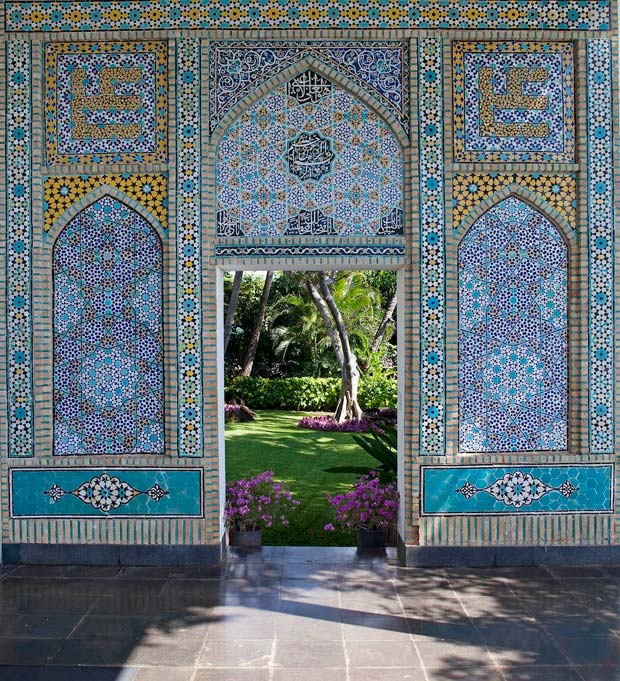 Mosaic tile panel in the form of a gateway, Iran, probably nineteenth century / Stonepaste monochrome-glazed, assembled as mosaic; On Shangri La’s dining room Ianai / Photo Credit: Tim Street Porter / Courtesy of Museum of Arts and Design
Mosaic tile panel in the form of a gateway, Iran, probably nineteenth century / Stonepaste monochrome-glazed, assembled as mosaic; On Shangri La’s dining room Ianai / Photo Credit: Tim Street Porter / Courtesy of Museum of Arts and Design
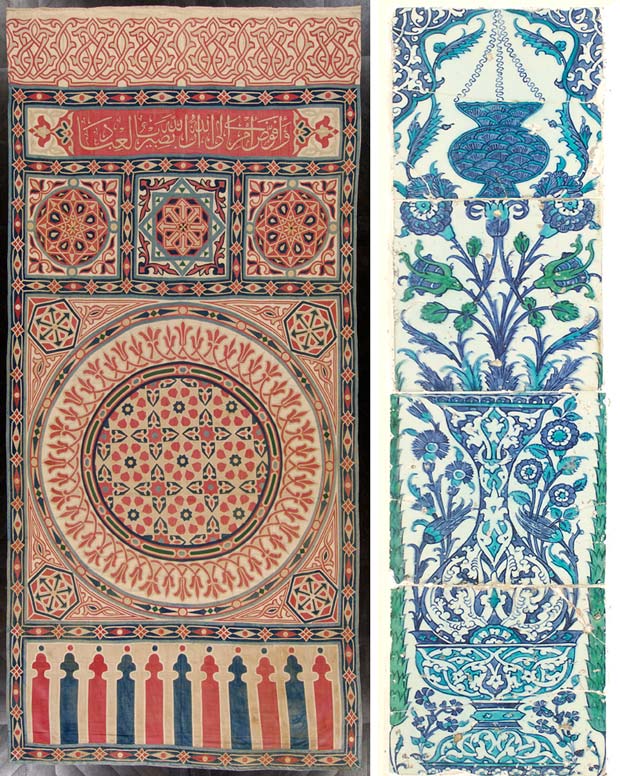 Left:Tent panel with Qur’anic inscription, Egypt, Cairo, nineteenth century. Cotton appliqué / 153 x 68 1/2 in / Photo Credit: © 2006 David Franzen. Doris Duke Foundation for Islamic Art, Honolulu, Hawai‘i / Right: Tile panel, Turkey, possibly Istanbul, ca. 1650 / Stonepaste: underglaze painted, 44 x 10 ½ in / Photo Credit: © 2003 David Franzen / Courtesy of Museum of Arts and Design
Left:Tent panel with Qur’anic inscription, Egypt, Cairo, nineteenth century. Cotton appliqué / 153 x 68 1/2 in / Photo Credit: © 2006 David Franzen. Doris Duke Foundation for Islamic Art, Honolulu, Hawai‘i / Right: Tile panel, Turkey, possibly Istanbul, ca. 1650 / Stonepaste: underglaze painted, 44 x 10 ½ in / Photo Credit: © 2003 David Franzen / Courtesy of Museum of Arts and Design
The contemporary work responding to modern-day Shangri La will include:
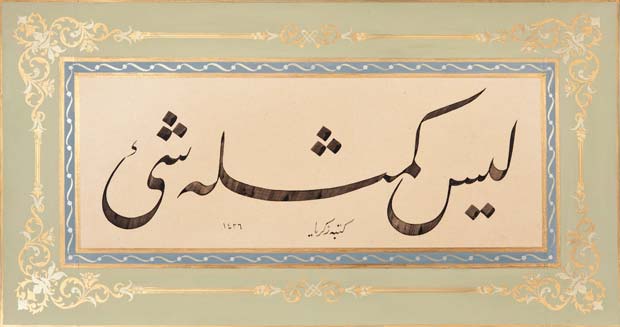 “There is nothing like Him†by Mohamed Zakariya, ink and gold on Turkish ahar paper in Jeli talik script, 23 1?4†x 12 1?4â€, 2005. / Photo Credit: David Franzen / Courtesy of Museum of Arts and Design
“There is nothing like Him†by Mohamed Zakariya, ink and gold on Turkish ahar paper in Jeli talik script, 23 1?4†x 12 1?4â€, 2005. / Photo Credit: David Franzen / Courtesy of Museum of Arts and Design
Today’s Shangri La will be brought to life in the exhibition through breathtaking large-scale photographs by Tim Street-Porter. One of the world’s most celebrated photographers of the built environment—and a trained architect in his own right—Street-Porter has brilliantly captured both the overall splendor of the spaces at Shangri La and a multitude of their details: the unfolding of views through ornately tiled doorways, the glow of hanging lamps under richly carved ceilings, the play of light through intricate grilled windows and the opening of framed vistas toward gardens and ocean. Documenting the inspiration for Shangri La and telling the story of its creation, the exhibition will present a trove of historic photographs, drawings, films and mementos. These include:
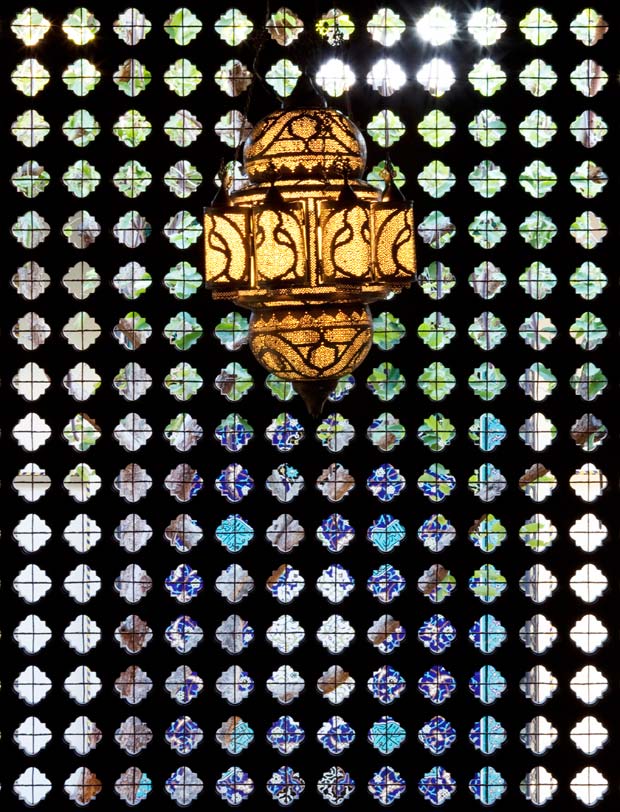 Pierced metal lamp in front of the wood grill, custom-made in Morocco in 1937- / Screening central courtyard from foyer at Doris Duke’s Shangri La, Honolulu, with view overlooking the Pacific Ocean; Tim Street-Porter / Photo Credit: © Tim Street-Porter. Doris Duke Foundation for Islamic Art, Honolulu, Hawai‘i / Courtesy of Museum of Arts and Design
Pierced metal lamp in front of the wood grill, custom-made in Morocco in 1937- / Screening central courtyard from foyer at Doris Duke’s Shangri La, Honolulu, with view overlooking the Pacific Ocean; Tim Street-Porter / Photo Credit: © Tim Street-Porter. Doris Duke Foundation for Islamic Art, Honolulu, Hawai‘i / Courtesy of Museum of Arts and Design
Shangri La was conceived by the 23-year-old Doris Duke in 1935, after her honeymoon with James Cromwell brought her through Muslim countries for the first time and concluded with an extended stay in Hawaii. Deeply impressed by the cultures she had encountered, and inspired to create a haven for the Islamic art she had collected during those travels, she commissioned a home in Honolulu to be designed by Marion Sims Wyeth (1889-1982). Wyeth was known for his work on many of the notable Palm Beach mansions (including the exterior of the Marjorie Merriweather Post estate, Mar-a-Lago) and was later to design the Norton Museum of Art in West Palm Beach. Taking an active role in developing the plans for Shangri La, Doris Duke intended the architecture to be influenced by the Islamic artworks and artifacts she had collected, and envisioned a growing collection that would be shaped in turn by the architecture.
Three historic buildings by Wyeth occupy the five-acre property. The collection ranges from pre-Islamic material to early 20th century commissions and is particularly strong in material from the 17th through 20th centuries and in ceramic tiles and vessels. Shangri La was opened to the public in November 2002 as a center for Islamic arts and culture. It is owned and operated by the Doris Duke Foundation for Islamic Art (DDFIA), which Doris Duke created in her will to promote the study, understanding, and preservation of Islamic art and culture.
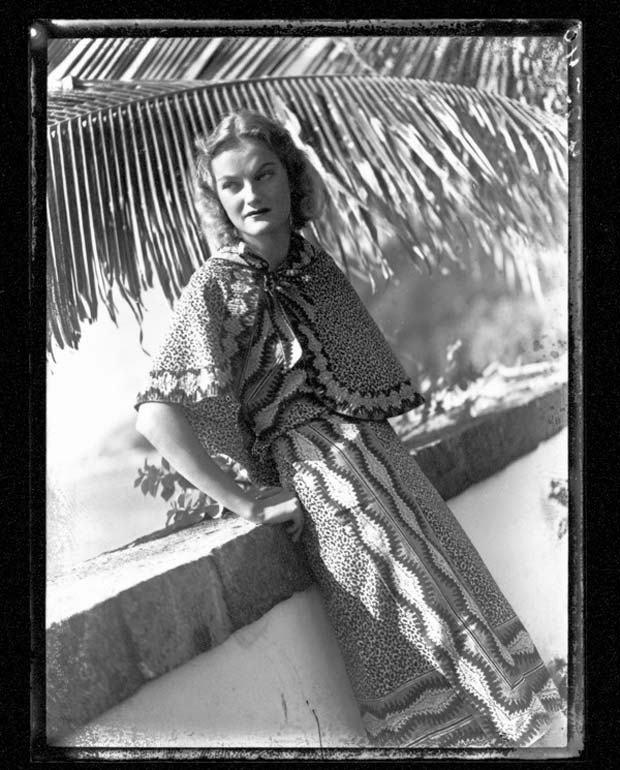 Doris Duke / Photo by Martin Munkacsi, 1939. / Photo Credit: Shangri La, Doris Duke Foundation for Islamic Art. Doris Duke Charitable Foundation Historical Archives, David M. Rubenstein Rare Book & Manuscript Library, Duke University, Durham, North Carolina / Courtesy of Museum of Arts and Design
Doris Duke / Photo by Martin Munkacsi, 1939. / Photo Credit: Shangri La, Doris Duke Foundation for Islamic Art. Doris Duke Charitable Foundation Historical Archives, David M. Rubenstein Rare Book & Manuscript Library, Duke University, Durham, North Carolina / Courtesy of Museum of Arts and Design
Born on November 22, 1912 in New York City, Doris Duke was the only child of James Buchanan (J.B.) Duke, a founder of the American Tobacco Company and Duke Energy Company. Upon his death in 1925, his fortune was divided between Doris, who was then only 12 years old, and the Duke Endowment—a foundation he established to serve the people of the Carolinas.
Intelligent, daring, and independent, Doris Duke used her wealth to pursue her personal interests, many of which were considered unconventional during the period but today reveal her prescience as a free-thinking adventurer. Among other things, she was an environmentalist long before it was fashionable; a war correspondent in Italy during World War II; a horticulturist who bred a new hybrid of orchid; a bold experimenter who learned to surf before the sport was widely known outside of Hawaii; and an early funder of AIDS research.
Doris Duke’s abundant interests also extended to foreign cultures. She developed a particular fascination with the societies and art of the Islamic world. On her many travels through these regions, she acquired countless treasures, most of which are now on display at Shangri La. In addition to collecting and commissioning art, she was both a patron and a participant of the performing arts, actively pursuing forms such as jazz piano and composition as well as modern dance—which she studied with celebrated choreographer Martha Graham.
A lifelong philanthropist, Doris Duke also contributed to a variety of public causes, including medical research and child welfare. When she was just 21, she established a foundation called Independent Aid through which she gave away the equivalent of hundreds of millions in today’s dollars—often as anonymous contributions. At age 56, she then established the Newport Restoration Foundation (NRF) to save the rapidly disappearing 18th-century architecture in Newport, Rhode Island. Finally, through her will, she established her ongoing legacy by calling for the creation of the Doris Duke Charitable Foundation (DDCF), which has to date awarded more than $1 billion in grants. (http://www.ddcf.org)
The Museum of Arts and Design explores the blur zone between art, design, and craft today. The Museum focuses on contemporary creativity and the ways in which artists and designers from around the world transform materials through processes ranging from the artisanal to digital. The Museum’s exhibition program explores and illuminates issues and ideas, highlights creativity and craftsmanship, and celebrates the limitless potential of materials and techniques when used by gifted and innovative artists. MAD’s permanent collection is global in scope and focuses on art, craft, and design from 1950 to the present day. At the center of the Museum’s mission is education. The Museum’s dynamic new facility features classrooms and studios for master classes, seminars, and workshops for students, families, and adults. Three open artist studios engage visitors in the creative processes of artists at work and enhance the exhibition programs. Lectures, films, performances, and symposia related to the Museum’s collection and topical subjects affecting the world of contemporary art, craft, and design are held in a renovated 144-seat auditorium.
Comments
Add a comment